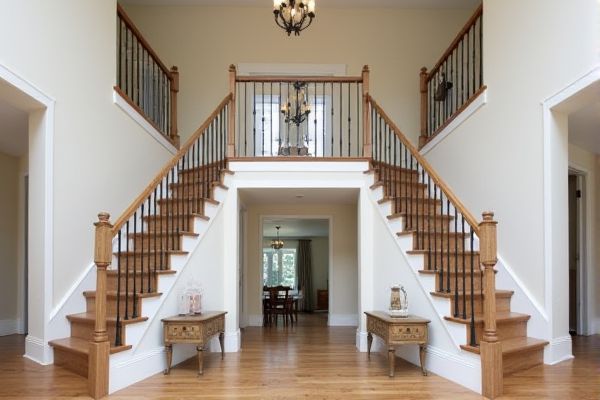
Double stringer stairs provide enhanced structural support and stability by featuring two parallel beams, while single stringer stairs use only one central beam, offering a minimalist design but potentially less rigidity. Discover which stair design best suits Your space and functionality needs by reading the full comparison in the article.
Table of Comparison
| Feature | Double Stringer Stairs | Single Stringer Stairs |
|---|---|---|
| Stringer Count | Two stringers, one on each side | One central stringer |
| Structural Support | Higher stability and load distribution | Moderate support, load concentrated centrally |
| Design Aesthetics | Traditional, symmetrical look | Modern, minimalistic appearance |
| Installation Complexity | Standard installation process | More complex; requires precise engineering |
| Cost | Generally lower due to simpler design | Typically higher due to engineering and materials |
| Application | Common in residential and commercial stairs | Used in contemporary designs and limited spaces |
| Material Usage | More timber or metal used on edges | Concentrated material in center stringer |
Introduction to Stair Stringers
Double stringer stairs feature two parallel stringers on either side, providing enhanced structural support and stability compared to single stringer stairs, which have only one central stringer. Single stringer stairs are typically used in lighter-duty applications or when a minimalist design is desired, while double stringer stairs are favored for their robust load-bearing capacity and durability. Choosing between single and double stringer stairs depends on factors such as expected traffic, aesthetic preferences, and structural requirements.
What Are Double Stringer Stairs?
Double stringer stairs feature two parallel support beams, or stringers, running along both sides of the staircase, providing enhanced stability and strength compared to single stringer stairs. These stairs distribute weight more evenly, making them ideal for heavy foot traffic and larger spans. Double stringer designs also allow for a wider range of material options and architectural styles, offering both functional and aesthetic benefits.
What Are Single Stringer Stairs?
Single stringer stairs feature one central support beam running directly beneath the middle of the treads, providing stability and a minimalist design. This configuration allows for open, airy staircases that are ideal for modern interiors where space and aesthetics matter. Your choice between single stringer and double stringer stairs impacts both structural support and visual appeal, with single stringers often used in lighter traffic areas or when a sleek, contemporary look is desired.
Design Differences: Double vs Single Stringer
Double stringer stairs feature two parallel support beams running along each side, providing enhanced stability and a balanced aesthetic suitable for wider structures. Single stringer stairs utilize one central support beam, offering a minimalist and modern design that emphasizes open space beneath the treads. The choice between double and single stringer affects load distribution, visual appeal, and installation complexity in architectural projects.
Structural Stability and Load Capacity
Double stringer stairs provide enhanced structural stability due to two parallel supports that evenly distribute weight across the staircase. Single stringer stairs rely on a central beam, which requires stronger materials to achieve comparable load capacity but may experience more flexing under heavy loads. Choosing double stringer stairs can increase your staircase's durability and safety, especially in high-traffic or load-demanding environments.
Aesthetic Appeal and Interior Design
Double stringer stairs offer a more robust and industrial aesthetic, often becoming a central architectural feature that enhances your interior design with clean lines and structural visibility. Single stringer stairs provide a minimalist and sleek look, creating an open and airy feel that complements modern or contemporary spaces by maximizing light flow and visual space. Your choice between double and single stringer stairs directly impacts the room's ambiance, balancing functionality with the desired design statement.
Installation Complexity and Requirements
Double stringer stairs require more precise installation due to the need for fixing two parallel supports that must be perfectly aligned, increasing structural stability but demanding advanced carpentry skills. Single stringer stairs feature a central support beam that simplifies installation by reducing the number of critical attachment points and minimizing floor reinforcement needs. Your choice affects installation time and labor costs, with single stringer designs generally offering a more straightforward and faster setup process.
Cost Comparison: Double vs Single Stringer
Single stringer stairs typically cost less than double stringer stairs due to reduced materials and simpler design requirements. Double stringer stairs offer enhanced structural support and durability, which can increase initial expenses but may lower long-term maintenance costs. You should weigh budget constraints against expected lifespan to determine the most cost-effective option for your project.
Safety Considerations and Compliance
Double stringer stairs offer enhanced safety and structural stability compared to single stringer designs, reducing the risk of warping or failure under heavy loads. Compliance with building codes often favors double stringers for public and commercial spaces, ensuring proper load distribution and handrail attachment points. Your choice should prioritize double stringer stairs when aiming for maximum safety and adherence to regulatory standards.
Choosing the Right Stringer for Your Staircase
Double stringer stairs offer enhanced stability and support, ideal for high-traffic areas or heavy loads, while single stringer stairs provide a sleek, modern appearance with easier installation and cost efficiency. Your choice depends on factors like stair width, aesthetic preference, and structural requirements to ensure safety and durability. Evaluating these aspects helps you select the right stringer that balances function and design for your staircase.
 homyna.com
homyna.com